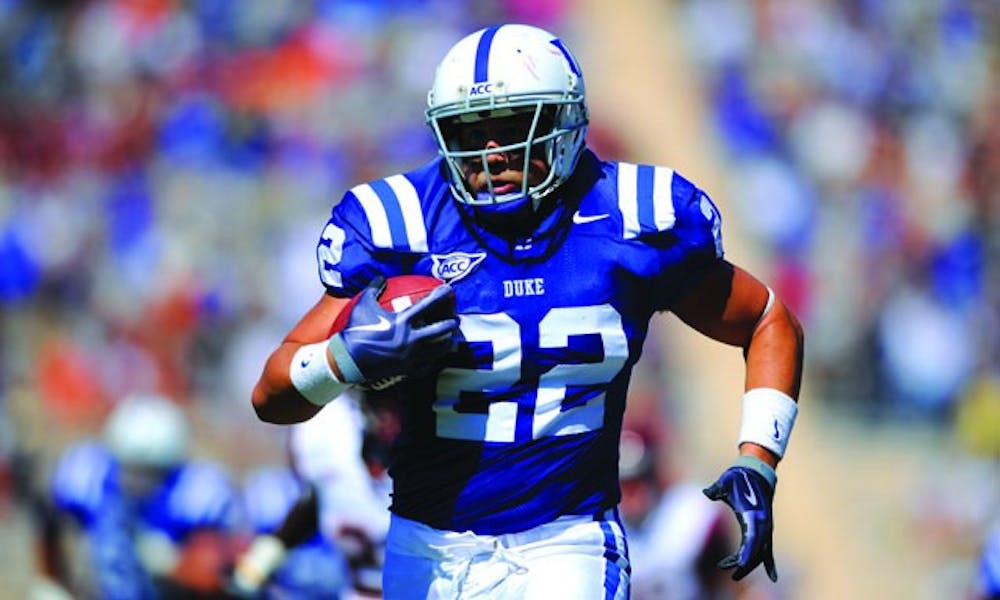After the offensive explosion in Duke’s last game against N.C. State in which the Blue Devils totaled 502 yards en route to scoring 42 points—the special teams scored another seven—it would appear to the casual observer that the offense is firing on all cylinders. However, that is not exactly the reality, as the rushing attack failed to get going and netted just 43 yards on the ground.
The Blue Devils’ inability to establish their ground game against formidable foes has been a well-chronicled problem this year. In fact, through six games, Duke is averaging a paltry 2.6 yards per carry and is only getting 83 rushing yards per game out of the backfield. In order to stay competitive against teams who are getting almost double that production, the coaching staff has had to alter its offensive game plan in search of ways to compensate for that output.
The answer has been to incorporate variations of existing formations into the playcalling and also to increase the roles of the tight end and the backfield in the aerial attack. Many of these passing plays—in which the running back, fullback or tight end is the primary option—function like running plays due to their conservative nature and high likelihood for picking up at least a couple of yards.
“A lot of things that are runs to us, like screen passes, underneath passes, aren’t runs in the box score,” head coach David Cutcliffe said. “There are different ways to skin the same cat.”
The outburst at N.C. State serves as a perfect example of the emphasis on getting more than just the wide receivers involved in the passing game. In that matchup, quarterback Thaddeus Lewis threw five touchdown passes and hooked up with a different target on each one. Three of the recipients of these scoring tosses were non-wide receivers: tight ends Brett Huffman and Danny Parker and running back Re’quan Boyette.
Since the start of ACC play, Lewis has been making a noticeable effort to get the ball into the hands of his tight ends. After combining for just five catches in the four nonconference contests, Huffman and Parker have had ten receptions combined in conference games against Virginia Tech and N.C. State.
Lewis has demonstrated his burgeoning confidence in the tight ends by turning to them in the red zone. Huffman, Brandon King and third-stringer Danny Parker have a touchdown apiece over the last two ACC games.
“These guys are just like receivers except for having the title of tight end,” Lewis said. “My job is to spread the ball around and get everyone involved in the offense.”
King’s touchdown against Virginia Tech perfectly illustrates the value and versatility of a tight end in an offensive game plan. On the 48-yard touchdown reception, King motioned into the backfield pre-snap, lining up almost as a fullback. Lewis took the snap and faked a handoff to the running back while King blocked for a second. Then, he leaked into the flat where he was left wide open and rumbled down the sideline untouched for the score.
King’s unusual pre-snap positioning, combined with his limited action in previous games, contributed to the Hokies not accounting for him on the play.
Cutcliffe has long been a proponent of not only getting his tight end involved in the offense but of doing so from a variety of pre-snap positions. Viewing the tight end as a hybrid of sorts who is capable of lining up in the backfield, as a wingback or even split out in the slot is a philosophy that Cutcliffe was forced to develop back in his days at Tennessee.
In 1984, he was serving as the tight ends coach for the Volunteers when then-head coach Johnny Majors decided to move to a two-back, three-receiver formation. Such a shift left a tight end out of the regular lineup.
Cutcliffe responded by forcing his tight ends to learn the roles and responsibilities of the fullbacks and wide receivers. Coincidentally, he observed the value of having a versatile tight end. With his current team, Cutcliffe still sees the tight ends growing to encompass bigger roles in the offense.
“Huffman and King are just now growing into what they can be,” Cutcliffe said. “Their impact makes a big difference in terms of what we can do on the offensive side of the ball.”
Huffman hasn’t noticed any difference in practice or game planning in terms of an emphasis on getting the ball to the tight ends. Instead, he gives credit to offensive coordinator Kurt Roper, who calls Duke’s plays from up in the box. Some plays are specifically designed to get the ball to the tight end. On others, Lewis has excelled at going through his progressions and checking down to one of his bulkier targets.
“I love getting the chance to make a play,” Huffman said. “For all the grinding and blocking, it’s a nice reward to see the ball coming my way.”
And because of the passing offense’s recent success, Huffman can count on an increased role for the tight ends even as the rushing game works toward improvement.
Get The Chronicle straight to your inbox
Signup for our weekly newsletter. Cancel at any time.

